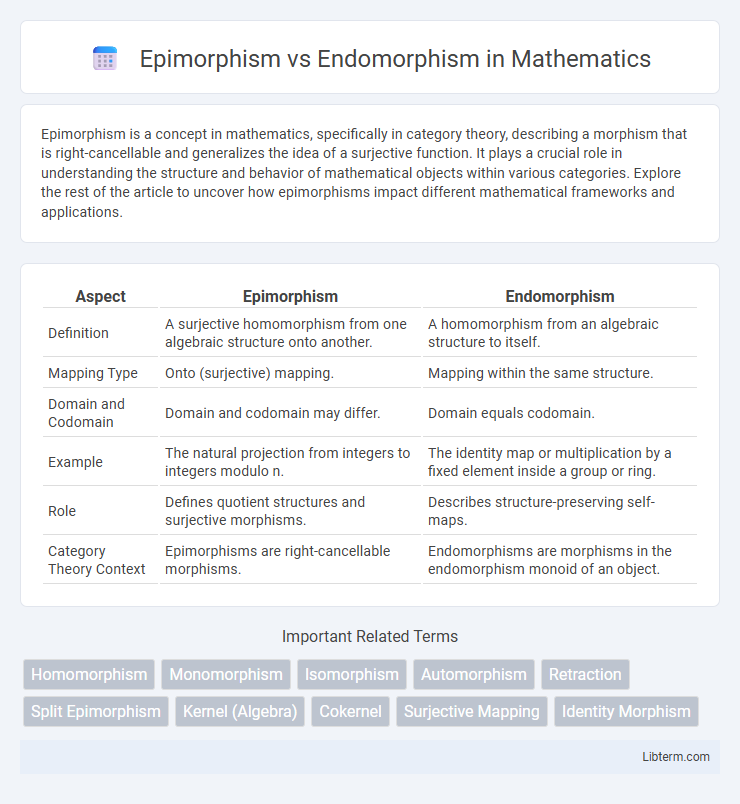Epimorphism is a concept in mathematics, specifically in category theory, describing a morphism that is right-cancellable and generalizes the idea of a surjective function. It plays a crucial role in understanding the structure and behavior of mathematical objects within various categories. Explore the rest of the article to uncover how epimorphisms impact different mathematical frameworks and applications.
Table of Comparison
| Aspect | Epimorphism | Endomorphism |
|---|---|---|
| Definition | A surjective homomorphism from one algebraic structure onto another. | A homomorphism from an algebraic structure to itself. |
| Mapping Type | Onto (surjective) mapping. | Mapping within the same structure. |
| Domain and Codomain | Domain and codomain may differ. | Domain equals codomain. |
| Example | The natural projection from integers to integers modulo n. | The identity map or multiplication by a fixed element inside a group or ring. |
| Role | Defines quotient structures and surjective morphisms. | Describes structure-preserving self-maps. |
| Category Theory Context | Epimorphisms are right-cancellable morphisms. | Endomorphisms are morphisms in the endomorphism monoid of an object. |
Introduction to Morphisms in Algebra
Epimorphisms and endomorphisms are fundamental types of morphisms in algebra, crucial for understanding structural mappings between algebraic objects. An epimorphism is a surjective homomorphism that preserves operations and maps elements onto the entire target structure, ensuring image coverage. Endomorphisms are homomorphisms from an algebraic structure to itself, revealing internal symmetries and automorphism subgroups when invertible.
Defining Epimorphism: Key Concepts
Epimorphism is a morphism in category theory characterized by being right-cancellative, meaning if two morphisms composed after it are equal, those morphisms themselves must be equal. This property makes epimorphisms the categorical analog of surjective functions in set theory, although not all epimorphisms are surjections in every category. Understanding epimorphism involves examining its role in factorization systems and how it contrasts with endomorphisms, which are morphisms from an object to itself.
Understanding Endomorphism: Core Principles
Endomorphisms are structure-preserving maps from an algebraic object to itself, crucial in studying the internal symmetries of mathematical structures like groups, rings, and vector spaces. They provide insights into invariant substructures and play a key role in fields such as linear algebra and module theory by enabling the analysis of eigenvalues, eigenvectors, and automorphisms. Understanding endomorphisms involves grasping the composition operation, identity morphisms, and kernel and image properties, distinguishing them from epimorphisms which focus on surjectivity between different objects.
Epimorphism vs Endomorphism: Main Differences
Epimorphism and endomorphism differ primarily in scope and functionality: epimorphism is a surjective morphism between two algebraic structures, ensuring every element in the target is mapped from the source, while endomorphism is a homomorphism from a structure to itself, preserving internal operations. Epimorphisms focus on onto mappings between potentially distinct objects, whereas endomorphisms concern structure-preserving transformations within a single object. These distinctions are critical in category theory and algebra for understanding morphism behavior in different contexts.
Properties and Characteristics of Epimorphisms
Epimorphisms are surjective homomorphisms in algebra that map elements from one structure onto another, ensuring every element in the target has a preimage. Unlike endomorphisms, which are homomorphisms from a structure to itself, epimorphisms preserve the algebraic operations and guarantee onto mappings, critical for quotient structures and homomorphic images. Their key properties include surjectivity, preservation of structure, and the ability to induce isomorphisms in certain contexts, making them fundamental in category theory and algebraic topology.
Properties and Characteristics of Endomorphisms
Endomorphisms are homomorphisms from a mathematical object to itself, preserving the internal structure such as operations or relations within algebraic structures like groups, rings, or vector spaces. Key properties include closure under composition, forming a monoid with the identity map as the neutral element, and often invertibility in the case of automorphisms. Unlike epimorphisms, which are surjective morphisms ensuring image coverage, endomorphisms emphasize structural self-maps that maintain the object's integrity without necessarily being surjective or injective.
Examples of Epimorphisms in Mathematical Structures
Epimorphisms appear frequently in algebraic structures such as groups, rings, and vector spaces, representing surjective homomorphisms preserving structure onto their target. An example in group theory is the natural projection map from a group G onto its quotient group G/N, where N is a normal subgroup, which is an epimorphism. In ring theory, the canonical surjection from a ring R onto the quotient ring R/I, with I as an ideal, serves as a standard example of an epimorphism, illustrating the concept's broad applicability.
Examples of Endomorphisms in Mathematical Structures
Endomorphisms appear in various mathematical structures such as vector spaces, where linear transformations from a vector space to itself serve as prime examples. In group theory, an endomorphism is a homomorphism from a group into itself, like the squaring map in an abelian group. Ring theory includes endomorphisms as ring homomorphisms mapping a ring onto itself, for instance, the multiplication by a fixed element in a commutative ring.
Importance and Applications in Algebra
Epimorphisms and endomorphisms play crucial roles in abstract algebra by characterizing morphisms in algebraic structures such as groups, rings, and modules. Epimorphisms are essential for understanding surjective homomorphisms, enabling the construction of quotient structures and factorization theorems, which are fundamental in algebraic classification and simplification. Endomorphisms, representing morphisms from an algebraic structure to itself, are vital in studying structure-preserving transformations, automorphisms, and invariant substructures, with applications ranging from module theory to linear algebra and system symmetries in physics.
Conclusion: Comparing Epimorphisms and Endomorphisms
Epimorphisms are surjective homomorphisms that map one algebraic structure onto another, ensuring that every element of the codomain is covered. Endomorphisms are homomorphisms from a structure to itself, highlighting internal transformations without altering the underlying set. Comparing these, epimorphisms emphasize surjectivity and structure-preserving onto mappings, while endomorphisms focus on internal symmetry and self-mapping within algebraic systems.
Epimorphism Infographic

 libterm.com
libterm.com